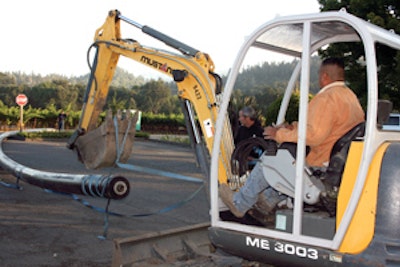Interested in Cleaning?
Get Cleaning articles, news and videos right in your inbox! Sign up now.
Cleaning + Get AlertsIn the middle of the grape-harvesting season at the Charles Krug Winery in St. Helena, Calif., workers washing 40,000-gallon fermenting tanks and wooden storage barrels noticed that the water drained slowly while the level in a manhole rose.
A contractor inspecting the 150-year-old 3-, 6- and 8-inch asbestos cement lines could not push his camera through the areas where acidic wine fumes had eroded the crown of the pipes, allowing soil to cave in. Other contractors waterjetting the lines pulled in more soil than they removed.
Jeff Rodgers, winery superintendent, asked Ryan Peterson, owner of Express Plumbing Affordable Trenchless Co. in Carmichael, Calif., if he could replace the 500-foot-long 8-inch pipe without tearing up the floor or interrupting winemaking. Peterson promised not to charge the winery if he failed. The men agreed with a handshake.
“I had doubts,” Peterson says. “We’d never keep the host pipe clean enough to line it – not with all that gravel falling in – and a fresh cave-in would collapse the liner. Pipe bursting was the only alternative.”
Peterson consulted Michael Lien, director of operations for TRIC Tools. He loaned equipment and offered advice. “The last thing we wanted was to halt production to dig up the floors if something went wrong,” says Peterson. Careful planning and coordination of daily schedules kept the winery operating at full capacity throughout the labor-intensive project.
Original building
Two 300- by 8-foot side aisles crossed the main aisle in the original winery building. Back-to-back fermenting tanks lined both sides of the side aisles. When workers washed the tanks, water ran into a trough and down 3-inch drain lines teed to a 6-inch feed line under the aisle, then emptied into the 8-inch pipe beneath the main aisle. That line drained by gravity to a 10-foot-deep manhole in the parking lot before flowing to a holding pond.
Peterson’s crew excavated the manhole for an entry pit, then devised a method to clean and televise the 8-inch pipe all the way to the 4-foot-deep manhole behind the building. “We went old school,” says Peterson. “We shoved 20-foot sticks of 2- and 3-inch pipe by hand through an open section of pipe until stopped by an obstruction.”
They then duct-taped a SeeSnake camera from RIDGID to the hose on Peterson’s trailer-mounted waterjetter from General Pipe Cleaners, shoved the hose out the smaller pipe, and turned on the water. A subcontractor vacuumed the debris.
When the hose on the reel paid out, workers used an electric saw to cut through the 8-inch-thick asbestos cement floor to where the camera had stopped, then hand-dug down to find it. Running water with the saw minimized dust. They repeated the process three times before reaching the upstream manhole and excavating it for the pulling pit.
“The ground was solid here, which is why we pulled upstream instead of downstream,” says Peterson. “Because we worked around the winemaking process, it took two weeks to clean 500 feet.”
The day of the pull, the men set up the cribbing, 24-inch-thick resistance plate, and 20 gpm/5,000 psi TRIC/Enerpac pump powering an M50 ram with 48 tons of pulling force and 19.24 square inches of piston area. Lien chose an 8-inch bursting head with 5.5-inch-diameter nose attached to a 5/8-inch swage cable to pull in the 8-inch HDPE SDR 17 pipe. The pull took four hours and was uneventful.
While you’re at it
Rodgers then asked Peterson to replace the 6-inch feed lines. “Working around the production schedule was our biggest impediment,” says Peterson. “We needed four 4-foot-square entry pits, one at each end of the two side aisles, and two 4-foot-square pulling pits above the new pipe in the main aisle.”
Workers potholed the 4-foot-deep excavations by hand. The preparation work and four pulls of 150 feet each took three weeks. The crew also cut 2-foot-wide sections across the side aisles to the drain line on each trough and replaced those pipes. They then cut 3-foot-square holes above the feed lines and tied in the drain lines before connecting them into the mainline. “We used electric saddle fusion fittings throughout the job to prevent the wine from deteriorating anything,” says Peterson.
Rodgers told Peterson to replace the last segment of asbestos cement pipe – a 10-inch line running under the barrel washroom to an unknown point. “The pipes entering the building were PVC,” says Peterson. “We found an access point and launched our camera and jetter setup. The old pipe ran straight from the building to a rose garden, turned 45 degrees, and converged with two 8-inch lines in the asphalt driveway in front of the scale house.”
The crew excavated 4-inch-square pulling pits at the conversion point and where the plastic pipe changed to asbestos cement outside the washroom. They excavated the entry pit in the rose garden. “Truckloads of grapes arrived all day for weighing,” says Peterson. “We stopped and started work a thousand times to stay out of their way.”
Lien replaced the 8-inch bursting head with a modified 8-inch static mole and switched to a 7/8-inch standard cable. “We welded on old cable grippers to increase the base diameter so it would accommodate a 10-inch burst,” he says. “The mole slides forward freely to facilitate removal in tight spots without having to disconnect the cable from the pipe.”
The total pull of 350 feet was flawless. After fusing the pipes and backfilling the holes, the crew cleaned the complete piping system all the way to the pond to remove any residual gravel. Peterson’s success led to similar work from other wineries.








